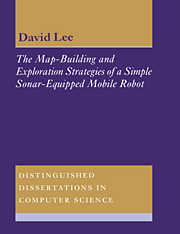 The Map-Building and Exploration Strategies of a Simple Sonar-Equipped Mobile Robot
The Map-Building and Exploration Strategies of a Simple Sonar-Equipped Mobile Robot Published online by Cambridge University Press: 05 March 2012
15.1 Motivation
This chapter describes a brief digression from autonomous exploration into human-guided exploration. The results in Chapter 14 showed Supervised Wall-Following to be an effective exploration strategy in environments with occlusion and traps. It was not, however, significantly better than simple wall-following in the ‘Empty’ environment. This raised the question:
Is it possible to improve the exploration performance in the ‘Empty’ environment or is Supervised Wall Following generating the best possible results, given the physical robot and its sensors?
To answer this question, experiments were performed to see whether a human operator, guided only by the developing map, could direct ARNE's movements so as to produce better results than Supervised Wall-Following. Similar experiments were performed in the more complicated ‘Walls’ environment.
15.2 Procedure
The exploration software includes an X-Windows interface which enables an operator to send commands (‘move forward’, ‘turn left’, ‘turn right’, and ‘scan’) directly to ARNE. This interface was used in the experiments described in this section. The interface also has the facility for the user to indicate, using the mouse, a position on the map to which ARNE should move. The system then plans and executes such a path. This facility was used for the longer movements between regions of interest.
Consideration was given to the choice of operator for these experiments. It was felt that a volunteer would have no experience of the way in which ARNE senses the world and builds the map and would therefore be unable to explore efficiently.
To save this book to your Kindle, first ensure [email protected] is added to your Approved Personal Document E-mail List under your Personal Document Settings on the Manage Your Content and Devices page of your Amazon account. Then enter the ‘name’ part of your Kindle email address below. Find out more about saving to your Kindle.
Note you can select to save to either the @free.kindle.com or @kindle.com variations. ‘@free.kindle.com’ emails are free but can only be saved to your device when it is connected to wi-fi. ‘@kindle.com’ emails can be delivered even when you are not connected to wi-fi, but note that service fees apply.
Find out more about the Kindle Personal Document Service.
To save content items to your account, please confirm that you agree to abide by our usage policies. If this is the first time you use this feature, you will be asked to authorise Cambridge Core to connect with your account. Find out more about saving content to Dropbox.
To save content items to your account, please confirm that you agree to abide by our usage policies. If this is the first time you use this feature, you will be asked to authorise Cambridge Core to connect with your account. Find out more about saving content to Google Drive.